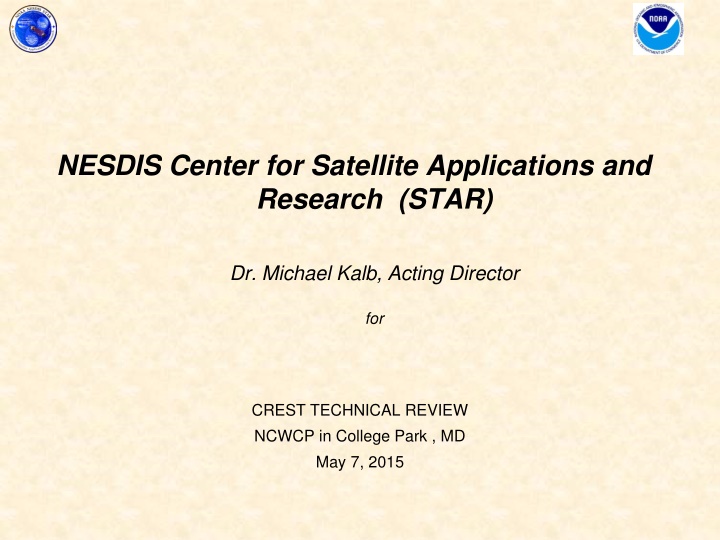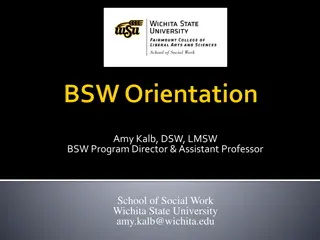
NOAA Satellite Applications and Research Center Overview
"Learn about the roles and responsibilities of the NOAA Center for Satellite Applications and Research (STAR), which focuses on transforming satellite observations into environmental information products to support NOAA's user communities. Discover how STAR leads research, development, and validation of satellite-derived products, develops new environmental applications, and collaborates with various organizations to enhance environmental prediction capabilities."
Download Presentation

Please find below an Image/Link to download the presentation.
The content on the website is provided AS IS for your information and personal use only. It may not be sold, licensed, or shared on other websites without obtaining consent from the author. If you encounter any issues during the download, it is possible that the publisher has removed the file from their server.
You are allowed to download the files provided on this website for personal or commercial use, subject to the condition that they are used lawfully. All files are the property of their respective owners.
The content on the website is provided AS IS for your information and personal use only. It may not be sold, licensed, or shared on other websites without obtaining consent from the author.
E N D
Presentation Transcript
NESDIS Center for Satellite Applications and Research (STAR) Dr. Michael Kalb, Acting Director for CREST TECHNICAL REVIEW NCWCP in College Park , MD May 7, 2015
Center for Satellite Applications & Research Center for Satellite Applications & Research Summary of Roles & Responsibilities STAR provides NOAA-relevant applied research, development, and science services to accelerate the transition and transformation of raw satellite observations into operational information products that support environmental assessments and predictions by NOAA land, atmosphere and ocean user communities. Lead NESDIS research, development, validation and maintenance of satellite derived products and applications from NOAA s operational geostationary and polar-orbiting satellites and from non-NOAA research and international satellites Develop new environmental applications, techniques and algorithms for transforming raw satellite observations into scientifically meaningful, quality assured and calibrated environmental measurements and products, and develop the pre-operational computer codes to implement them; Support the calibration and validation of all satellite sensors used in NOAA s satellite operations, develop methods and maintains systems for inter-calibrating NOAA satellite data with other agency and international satellites constellations. Work with other NESDIS and NOAA offices, universities, NASA and other U.S. agencies, and with international organizations on exchange and evaluation of operational and research satellite data and products; Interfaces with NESDIS and NOAA operational organizations to improve the use of satellite data in operations, accelerating the transfer of new techniques and new satellite data sources (domestic or foreign) into NOAA operations to improve environmental prediction.
STAR Science Services Instrument & Product Calibration /Validation 4.0 Science 4.3 4.3.1 Development, coordination and execution of instrument and product Calibration / Validation techniques, technologies and activities; Science & Product Systems Development 4.1 4.1.1 Scientific algorithm & product systems development 4.3.2 Interagency and international cal / val program coordination activities 4.1.2 Calibration / validation systems development 4.3.3 Cal/Val campaigns 4.1.3 Software and Algorithm Integration 4.1.4 Configuration control and change management Science Project & Program Management 4.4 4.1.5 Quality Assurance 4.4.1 Program and Project level mission science leadership and coordination 4.4.2 Science Team Management & Support Science and Product Services 4.2 4.4.3 Organization and coordination of internal and / or external science community working groups, review boards, and advisory services 4.2.1 Requirements development and analysis 4.2.2 Scientific algorithm & applications research, prototype development, testing, and validation Post Launch Science Maintenance 4.5 4.5.1 Science algorithm and instrument performance monitoring 4.2.3 Risk Reduction & Proving Grounds 4.5.2 4.5.3 Satellite / instrument performance issues mitigation services Calibration updates and algorithm changes necessary to ensure product quality or correct for unanticipated anomalies or artifacts 4.2.4 User Readiness 4.2.5 Product Improvement Long Term Monitoring Product Monitoring and long term error assessment Reprocessing of long term data to ensure highest quality 4.6 4.6.1 4.6.2 3
Center for Satellite Applications and Research (STAR) Director M. Kalb, Acting Administrative Services STAR Senior Scientist (vacant) Deputy Director Michael Kalb IT Systems O&M General Purpose Science Processing Joe Brust Joint Center for Sat. Data Assimilation Sid Boukabara Admin Officer Gretchen Taylor Chief of Staff (vacant) Ocean Data Assimilation Scientist Eric Bayler NOAA Calibration Center Changyong Cao Satellite Meteorology & Satellite Oceanography & Climatology Division Paul Digiacomo Cooperative Research Programs Division Chris Brown (act) 22 Climatology Division Fuzhong Weng CREST 1 Environ. Monitoring and Climate Branch Ivan Csiszar Ocean Physics Branch (Satellite Altimetry) Laury Miller Regional & Mesoscale Meteorology Branch Don Hillger (act) CIRA Satellite Calibration & Data Assimilation Branch Changyong Cao (act) Marine Ecosystems & Climate Branch Menghua Wang Advanced Satellite Products Branch Jeff Key CIMSS Operational Products Development Branch Laurie Rokke Ocean Sensors Branch Sasha Ignatov Satellite Climate Studies Branch Ralph Ferraro CICS
Center for Satellite Applications and Research (STAR) Discipline Scientific Workforce Satellite Meteorology & Climatology Division Cooperative Research Program Division Satellite Oceanography & Climatology Division Quality Assurance, Calibration / Validation, SW & Systems Engineering, Project Management, Cost, Schedule & Performance Management, Documentation, Research to Operations, Standards, Formats Enterprise Service Support Integrated Calibration & Validation System Community Radiative Transfer Model Collaborative Environment / SCDR Specialized Capabilities & Systems NOAA STAR NOAA STAR NOAA STAR, Int l NOAA Calibration Center Global Satellite Intercalibration System Joint Center for Satellite Data Assimilation NOAA STAR, NASA, NIST NOAA STAR, NCEP, NASA, USN, USAF NOAA STAR, WMO, CEOS, Int l NASA NOAA LEO / GEO NPP/JPSS GOES-R Decadal Survey International Constellations JASON DMSP METOP Missions U.S. and International Research Satellites Considered for Operational Use in NOAA 5
Satellite Strategies in Transition PRESENT PAST FUTURE Calibrate individual instruments Inter-calibrate multiple instruments globally Stovepipe Development of algorithms for GEO & LEO instruments Develop individual products Develop common algorithms and processing frameworks for GEO and LEO instruments Develop product suites and blended products Transfer algorithms to NESDIS/OSPO Transfer algorithms to NESDIS/OSPO & International and non-government partners Address internal NOAA requirements Participate in multiple US and international collaborations Study climate using single instruments Study climate using chains of instrument data Assimilate data from individual satellites Assimilate data from suites of satellites Manage projects for Principal Investigators Manage algorithm deliveries to entire acquisition programs 6
Satellite Strategies in Transition PRESENT PAST FUTURE Calibrate individual instruments Inter-calibrate multiple instruments globally Stovepipe Development of algorithms for GEO & LEO instruments Develop individual products Develop common algorithms and processing frameworks for GEO and LEO instruments Develop product suites and blended products Transfer algorithms to NESDIS/OSPO Transfer algorithms to NESDIS/OSPO & International and non-government partners Address internal NOAA requirements Participate in multiple US and international collaborations Study climate using single instruments Study climate using chains of instrument data Assimilate data from individual satellites Assimilate data from suites of satellites Manage projects for Principal Investigators Manage algorithm deliveries to entire acquisition programs The key to understanding where STAR is going, is to know where science in NESDIS is going NOAA Science, Service and Stewardship 7
Educational Partnership Program (EPP) Technically excellent, and comprehensively responsive to NOAA partnership, scientifically appropriate, well executed & managed Leveraging into other government agency activities via their faculty and partners Hampton University, University of Puerto Rico at Mayaguez, California State University Los Angeles, UMD Baltimore County True to Original Charter and History of CCNY Devoted to welfare and interests of students A Key measure of commitment to the partnership, is extent to which NOAA relevant technologies, concepts and interests are reflected in curriculum and curriculum development What capabilities and skills can we impart to you? What capabilities and skills can you impart to us?
Educating NOAA about what it does Communicating Science is what you do (University Students ~Lay Audiences Students, We need to communicate science better inside and outside NOAA Basic understanding of physical earth and environmental system mission. Basic understanding of technologies and capabilities, and of how and what we do to accomplish our mission. Work with STAR develop and deliver lay level courses to NOAA personnel: How the Earth Works, How Satellites Work Embed STAR Scientist for period at CREST, co-offer graduate seminar course

